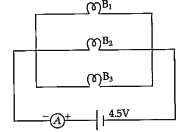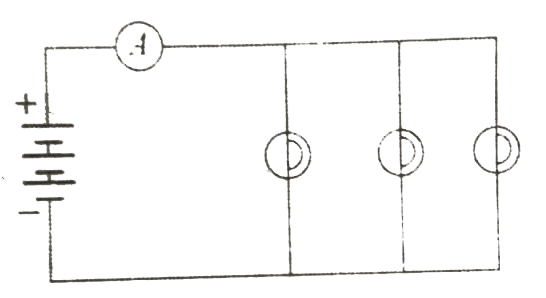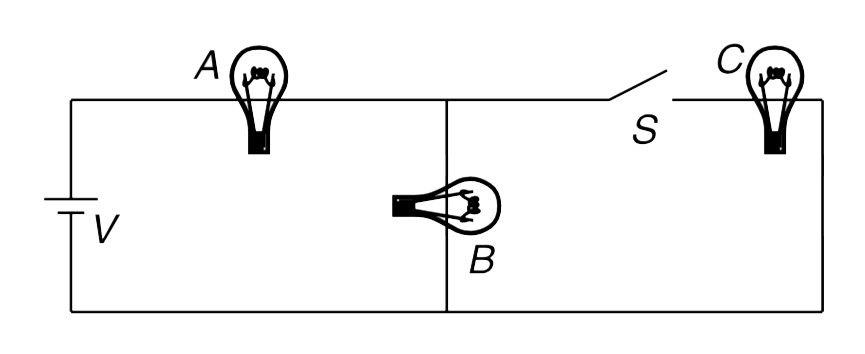
If the wattage of each bulb is 1.5 W, how much reading will the ammeter A show when all the three bulbs glow simuteously.
1.0A
2A
1.5W
None of the above
The correct Answer is:A
When the bulbs are in parallel, wattage will be added (4.5 W) and the ammeter reading would be,
I=P/V=4.54.5=1A
Similar Questions
B1,B2andB3 are three identical bulbs connected as shown in (fig. 3.46). When all the three bulbs glow, a current of 3A is recorded by the ammeter A.
(i) What happens to the glow of the other two bulbs when the bulb B1 gets fused ?
(ii) What happens to the readings of A1,A2,A3andA when the bulb B2 gets fused ?
(iii) How much power is dissipated in the circuit when all the three bulbs glow together ?
 .
.
View SolutionB1,B2,B3 are three identical bulbs connected as shown in figure. Ammeters A1,A2,A3 are connected as shown. When all the bulbs glow, the current of 3A is recorded by ammeter A.
(i) What happens to the glow of the other two bulbs when bulb B1 gets fused?
(ii) What happens to the reading of A1,A2,A3 and A when the bulb B2 gets fused?
(iii) How much power is dissipated in the circuit when all the three bulbs glow together?

View Solution
Knowledge Check
If the wattage of each bulb is 1.5 w , what will be the reading in the ammeter A when all the three bulbs glow simultaneously.
 A1.5 AmpereB1.0 AmpereC0.1 AmpereD0.5 Ampere
A1.5 AmpereB1.0 AmpereC0.1 AmpereD0.5 AmpereThere 60W, 120V light bulbs are connected across a 120V power source. If resistance of each bulb does not change with current then find out total power deliver to the three bulbs.
 A180WB20WC40WD60W
A180WB20WC40WD60WThree similar light bulbs are connected to a constant to a constant voltage dc supply as shown in Fig.7.32. Each bulb operates at normal brightness and the ammeter ( of negligible resistance) registers a steady current. The filament of one of the bulbs breaks. What happens to the ammeter reading and to the brightness of the remaining bulbs?
 AAmmeter reading - increases, Bulb brightness - increasesBAmmeter reading - increases, Bulb brightness - unchangedCAmmeter reading - unchanged , Bulb brightness - unchangedDAmmeter reading - decreases, Bulb brightness - unchanged
AAmmeter reading - increases, Bulb brightness - increasesBAmmeter reading - increases, Bulb brightness - unchangedCAmmeter reading - unchanged , Bulb brightness - unchangedDAmmeter reading - decreases, Bulb brightness - unchanged
Three incandescent bulbs of 100 W each are connected in series in an electrical circuit. In another circuit another set of three bulbs of the same wattage are connected in parallel to the same source.
(a) Will the bulb in the two circuits glow with the same brightness? Justify your answer.
(b) Now let one bulb in both the circuits get fused. Will the rest of the bulbs continue to glow in each circuit? Give reason.
View SolutionThree incandecent bulbs of 100W each are connected in series in an electric circuit. In another circuit another set of three bulbs of the same wattage are connected in parallel to the same source.
(a) Will the bulbs in the two circuits glow with the same brightness ? Justify your answer.
(b) Now let one bulb in both the circuits get fused. Will the rest of the bulbs continue to glow in each circuit ? Give reason.
View Solution(a) How much current will an electric bulb draw from a 220V source, if the resistance of the bulb filament is 1200Ω ?
(b) How much current will an electric heater draw from a 220V source, if the resistance of the heater coil is 100Ω ?
View SolutionA and B are two identical bulbs of 40W connected to a V=12 volt cell. Switch S is closed to connect a third bulb C in the circuit. What happens to brightness of bulb A? Answer for two cases:
(i) Bulb C is a very high wattage bulb.
(ii) Bulb C is a very low wattage bulb.
All the three bulbs have rated voltage of 12 volt.

View SolutionA torch bulb rated 4.5W,1.5V is connected as shown in Fig. 7.35. The emf of the cell needed to make the bulb glow at full intensity is

View Solution

